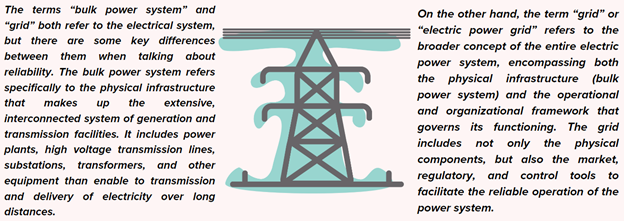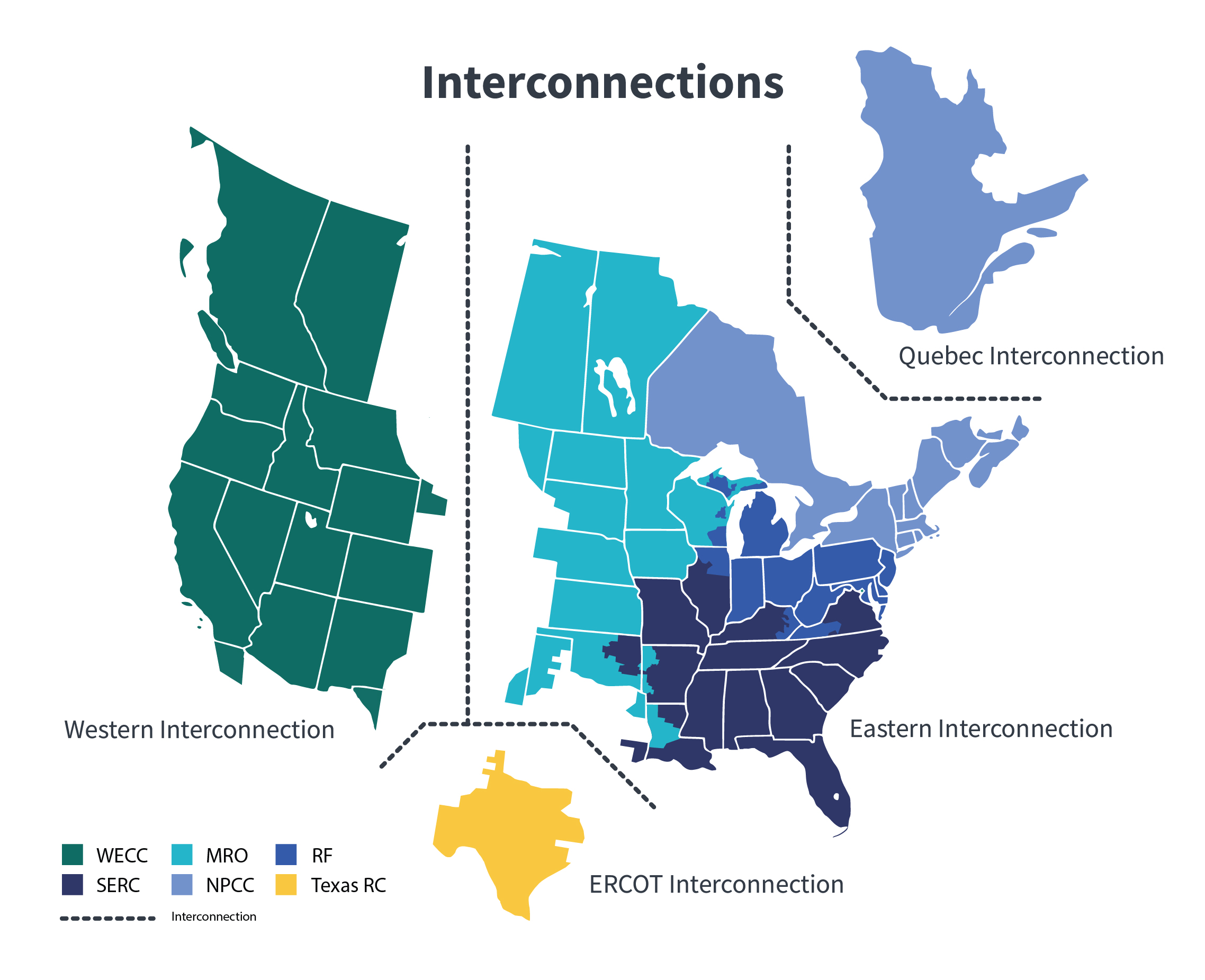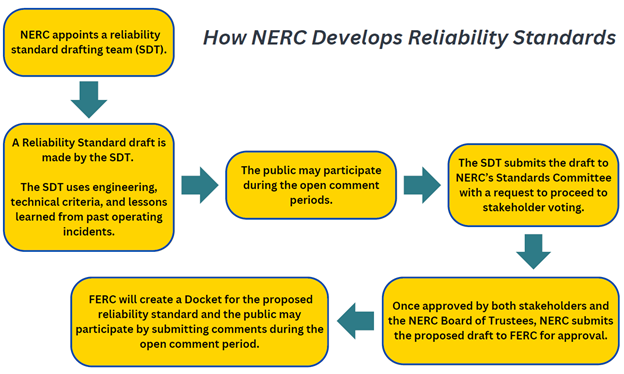Introduction
The Federal Energy Regulatory Commission (FERC) is a government agency that oversees the interconnected electricity grid in the United States. FERC’s reliability jurisdiction is primarily over what is known as the “bulk power system.”[1] The bulk power system includes the vast network of generation, transmission, and a limited set of distribution system components necessary for operating and maintaining grid reliability. To maintain the reliability of the bulk power system, FERC reviews, approves, and enforces mandatory reliability standards developed by an organization called the North American Electric Reliability Corporation (NERC). We will discuss FERC, NERC, and other key concepts in more detail below.
The electric grid is constantly challenged by factors that could cause major problems. As an electric consumer, you may be familiar with periodic disruption to your home’s electric service, a “power outage.” This may occur when a tree limb falls on a distribution line during a storm or when lightning strikes a substation. Power outages aren’t limited to severe weather. For example, a car colliding into a utility pole and knocking it over can also be a cause of a power outage. These examples relate to local distribution lines owned and controlled by your utility, which are often connected to the standard wooden utility pole. Such lines are overseen by your state public utility commission. In contrast, FERC has jurisdiction over the transmission of electricity in interstate commerce, typically along lines connected to much taller, metal structures. While FERC-approved mandatory reliability standards do not apply to local distribution lines, what happens at the transmission level has a direct effect on electric service to customers.
What is Grid Reliability?
Grid reliability is the provision of an adequate, secure, and stable flow of electricity as consumers may need it. In other words, when you flip the light switch, the lights turn on. The grid remains functional even during unanticipated but common system disturbances, such as loss of a source of energy generation from an energy provider or failure of some other system element. When something fails, the grid has to be able to isolate the problem and keep functioning.
Grid reliability is based on two key elements:
- Reliable operation – A reliable power grid has the ability to withstand sudden electric system disturbances that can lead to blackouts.
- Resource adequacy - Generally speaking, resource adequacy is the ability of the electric system to meet the energy needs of electricity consumers. This means having sufficient generation to meet projected electric demand.
FERC’s reliability jurisdiction primarily focuses on reliable operation of the grid. The aim is to ensure the real-time and day-to-day operations of the grid by developing and enforcing operational and business standards. However, there are other factors that also support grid reliability.
For example, long-term resource planning, which includes deciding on what is a sufficient resource mix for a reliable electric system - not just for today but for the future - is not under FERC’s authority. The construction of additional generation or transmission, or the initiative to develop reliability standards for adequacy of electric facilities or services, typically fall under the jurisdiction of state or local public utility commissions. These resource adequacy considerations also contribute to a reliable electric system.
FERC, NERC and the Electric Reliability Organization
Historically, when regional blackout events have happened, policy changes have been implemented to improve reliability and reduce the risk of power outages. On November 9th, 1965, a power failure in Ontario, Canada cut off power to over 30 million people in parts of Canada, New York, New Jersey and most of New England.[2] As part of its investigations into that blackout, FERC recommended the creation of a voluntary system of reliability measures. This led to the creation of the North American Electric Reliability Corporation (NERC). NERC has since operated in this role as a voluntary industry organization for over 30 years.
Another massive regional blackout resulted in a major consolidation of the nation’s reliability framework. On August 14, 2003, the North American power grid’s largest blackout led to several policy measures to strengthen the U.S. electric grid.[3] Underscoring the fact that grid operators are highly dependent on each other, and that a problem hundreds of miles away can lead to a blackout in another area, policymakers and industry representatives argued for mandatory reliability rules. As a result, Congress passed the 2005 Energy Policy Act, which called for the designation of an Electric Reliability Organization that “develops and enforces mandatory standards for the [r]eliable operation and planning of the bulk power system.”[4]
In 2006, FERC certified NERC as the Electric Reliability Organization for the United States mainland, not including Alaska and Hawaii. This designation tasked NERC with developing –
subject to FERC approval and oversight -- reliability standards that could now be legally enforced. In addition, NERC has electric reliability responsibilities in Canada and the northern portion of Baja California, Mexico. Thus, NERC covers users, owners, and operators of the North American bulk power system, which serves nearly 400 million people. NERC’s stated mission is to assure the effective and efficient reduction of risks to the reliability and security of the grid.[5]
As a not-for-profit international regulatory authority, NERC works with representatives from a broad range of stakeholder categories and develops reliability standards to address bulk power system reliability and security. FERC must approve these standards before they become mandatory and enforceable in the United States. All users, owners and operators of the bulk power system registered with NERC must follow the mandatory reliability standards. The reliability standards aim to support the electric system and instruct grid operators on how to plan, operate, and protect the grid from various threats. For example, the reliability standards include training and communication requirements, as well as requirements for grid operators to have back-up plans in case of emergencies.
Further, the NERC reliability standards require owners of transmission lines to have a vegetation management program to assure that trees do not interfere with or fall into transmission lines, historically a major cause of cascading blackouts.[6] Currently, there are over 80 mandatory reliability standards in effect that address many aspects of reliable operation of the nation’s electric grid. (As noted above, other aspects, such as generation resource adequacy and transmission line siting, are primarily dealt with by state and local bodies).
How NERC Develops Reliability Standards
The development of a new or modified reliability standard or the retirement of an existing standard may be instituted by either (1) a directive from FERC to address a specific reliability matter, or (2) a request by a person or entity, including members and groups from NERC’s staff. NERC has a Standards Committee that reviews such requests and will authorize the development of a proposed standard if there is sufficient stakeholder consensus on the scope of and need for the new or modified reliability standard.[7]
The NERC Standards Committee appoints a “reliability standard drafting team” (SDT) that has the technical expertise, competencies, and diversity of views that are necessary to develop the standard. The SDT develops a draft Reliability Standard based on engineering and technical criteria and on actual data and lessons learned from operating incidents. All meetings of the drafting team are open and notice of the meeting is provided to the public. The public, as observers, may comment on issues during SDT meetings but do not vote on the final language that determines the draft reliability standard. However, the public may participate in public comment periods.
The drafting team submits the draft reliability standard to NERC’s Standards Committee with a request to proceed to stakeholder balloting. NERC has ten stakeholder groups that participate in the balloting, representing the various industry interests in the bulk power system such as generators, transmission operators and end use customers. This latter group includes industrial customers, vendors and other entities but does not include individual/homeowner consumers. Once approved by a supermajority vote of stakeholder groups and then by the NERC Board of Trustees, NERC submits the proposed reliability standard to FERC for approval. At this point, the public has the opportunity to submit comments in the relevant FERC Docket on the proposed reliability standard.[8]
FERC’s Role in Electric Grid Reliability
FERC performs its oversight of grid reliability through approval and enforcement of mandatory reliability standards. In addition, FERC reviews and approves NERC’s annual budget and business to assure that NERC has the necessary resources to perform its reliability mission.
As noted, NERC submits proposed new or modified reliability standards to FERC for approval before they become mandatory and enforceable. Upon submission, FERC provides public notice and an opportunity for public comment on the reliability standards under review. Sometimes FERC issues a simple notice seeking comments by a stated deadline. On other occasions, FERC may issue a notice of proposed rulemaking that lays out specific issues and proposals related to the NERC filing. This allows the public to respond to the NERC proposed reliability standard, as well as the issues under consideration by FERC. Occasionally, FERC may hold a public conference to discuss the impacts and effectiveness of a NERC proposal. FERC provides a public notice and agenda in advance of a technical conference. After review of public comments, FERC issues an order or final rule either accepting or rejecting the proposed reliability standard and explaining the reason for the decision.
Additionally, FERC can advance reliability improvements by directing NERC to develop new or modified reliability standards to address emerging grid issues such as certain power plant retirements and integration of renewable energy resources. FERC has also taken action to assure that the electric grid is prepared to reliably operate during more frequent and more extreme weather events.
Compliance and Enforcement of Reliability Standards
Both NERC and FERC have authority to enforce compliance with reliability standards. Enforcement tools include investigations, audits, spot checks and self-reporting of violations. While monetary penalties can be over $1 million per day, per violation, the highest penalties for non-compliance typically are applied in egregious circumstances such as violations that result in cascading blackouts or systematic compliance failures.
NERC has delegated compliance oversight to six regional entities. NERC provides industry-wide perspective and oversight, while the regional entities oversee regional constituents based on the unique circumstances in each region. Any monetary penalty assessed by NERC or a regional entity must be submitted to FERC, with an opportunity for the alleged violator to seek FERC review, before the consequences of the violation take effect.
Grid Security
A key aspect of reliability, grid security is the protection of the bulk power system from physical or cyber-attacks that could disrupt normal grid operation and cause blackouts and damage to facilities. FERC has a two-pronged approach to cyber and physical security.
First, FERC and NERC develop and approve reliability standards that address cyber and physical security for the bulk power system. Currently, there are 13 reliability standards that address different aspects of cyber security that collectively require a baseline set of cyber security protections for all bulk power system cyber systems. Likewise, a mandatory physical security standard requires the protection of critical facilities that, if harmed by a physical attack, could interrupt reliable operation of the bulk power system. FERC provides public notice and opportunity for comment prior to making final decisions on modifications to the physical and security related reliability standards.
Second, FERC has a voluntary program that works with the electric industry to encourage and support the implementation of best practices for cyber and physical security, above and beyond the mandatory baseline set forth in the reliability standards.
To ease the risks of a physical or cyber-attack, grid security requires constant monitoring, maintenance, and improvement of the physical and digital infrastructure of the power system. Grid security further requires consistent coordination and collaboration among various stakeholders, such as utilities, regulators, government agencies, industry associations, and customers.
[1] https://www.nerc.com/pa/Stand/2018%20Bulk%20Electric%20System%20Definition%20Reference/BES_
Reference_Doc_08_08_2018_Clean_for_Posting.pdf
[2] https://www.baruch.cuny.edu/nycdata/disasters/blackouts-northeast.html#:~:text=The%20blackout%2C%20which%20lasted%20for,many%20were%20stuck%20in%20elevators.
[3] The next major U.S. blackout event occurred in 1977 in New York City. This blackout lasted for nearly 24 hours and affected almost all parts of New York City.
[4] https://www.congress.gov/109/plaws/publ58/PLAW-109publ58.pdf
[6] For more information on tree trimming, vegetation management and landowner rights see: Tree Trimming and Vegetation Management | Federal Energy Regulatory Commission (ferc.gov).
[7] https://www.nerc.com/pa/Stand/Pages/default.aspx
[8] https://www.nerc.com/comm/SC/Documents/Appendix_3A_StandardsProcessesManual.pdf



